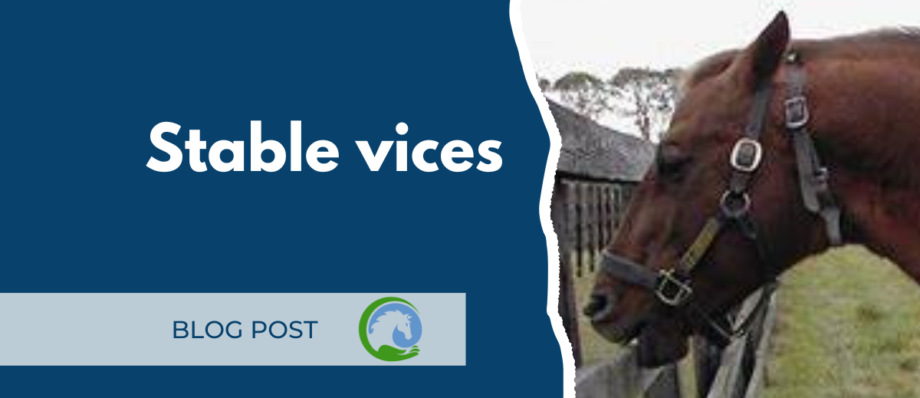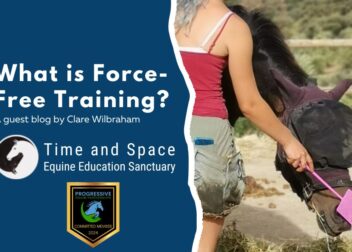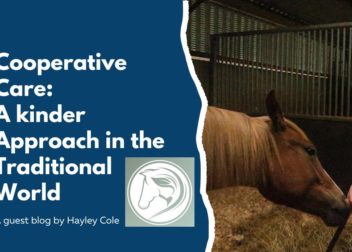Stable vices
‘Stable vice’ is a term used to describe undesirable behaviours displayed by stable kept horses. These stereotypical behaviours, once established, can be difficult to change.
The exact cause of stable vices are unclear but environment is likely to play a significant role. Horses are designed to be on the move, grazing throughout the day. Many generations of breeding domestic horses has ensured that most horses are well adapted to stabled life. However it must be remembered that in the horses natural environment they would graze in a herd for 70% of the day.
The causes of stable vices can include early weaning, intense training, incorrect feeding, unsuitable housing, lack of social contact and boredom. A confined horse can feel alone and anxious, isolated from other horses and may start to display problem behaviours. Sudden changes to routine and/or environment can also spark problem behaviour.
Cribbing and windsucking

Cribbing is a repetitive behaviour where the horse places its upper teeth against a stationary surface such as the stable door, arches its neck, and pulls backwards with its body while making a grunting sound. Windsucking is similar to cribbing, but the horse doesn’t place its teeth on an object.
Once a horse has started to crib bite or windsuck it is very hard to stop the behaviour. Over time a horse who crib bites can wear down his incisors (front teeth) down to the gum. This can lead to digestive issues such as colic, ulcers and weight loss as the horse is unable to graze.
Some people attempt to stop the behaviour by covering suffices with something foul tasting, using electric tape around fences and fence posts, putting a muzzle on or putting a tight collar around the horses neck. All of these may prevent the behaviour occurring but they do not address the reason for the behaviour developing in the first place. By preventing the horse from cribbing or windsucking his coping mechanism is removed, this can lead to further stress.
Cribbing is a learned, obsessive-compulsive behavioural disorder, and can be difficult, if not impossible, to break permanently. Research has shown that cribbing results in the release of endorphins, which make the horse, feel good. In a way the horse becomes addicted to this behaviour but with correct management (environment, diet, distraction etc) the behaviour can be significantly reduced.
Weaving
Weaving is a side-to-side movement of the horse’s neck and weight, which sometimes occurs with lifting and lowering of the forelegs alternately. It is a repetitive behaviour usually associated with stable kept horses. The behaviour is less commonly seen in the field, however some stable kept horses may weave at the gate when turned out particularly if stressed due to being left alone, lack of grazing or anticipation of coming into the stable for feeding.
Weaving is usually a result of stress or anxiety resulting from long periods in stable without exercise or social interaction and a regular routine.
Excessive reputation of this behaviour can cause damage to tendons and the hoof.

Some stables have anti weave grills on the door to stop the horse being able to sway from side to side. However, when an anti weave grid is used, the horse will often step back and weave inside the stable.
Box walking

Box walking involves repeated episodes of aimless walking either around the stable or along a wall. This behaviour can be continuous or only witnessed at certain times when the horse is anxious for example feed time or before turning out.
Horses who are stabled for long periods of the day may box-walk to the extent where the muscles on one side of their body develop more than those on the opposite side of the body, as the box-walking normally occurs in one preferred direction. Some horses will box-walk to the extent that they are exhausted by the effort
Prevention and management

Find ways to add mental and physical stimulation to your horse’s daily routine. This usually includes increasing the amount of time the horse spends turned out. If this is not an option, providing more roughage in the horse’s diet may also help. Giving your horse toys to play with will help provide mental stimulation. Increasing the amount of time you spend interacting with your horse is also important.
If anxiety is suspected to be the cause of a stable vice consider looking at the horses routine. For example if the horse presents the behaviour less after exercise, try exercise in the morning.
If excess energy might be the cause, have a look at the horses diet. Is there a high sugar content?
If boredom might be the cause try stable toys, adlib hay, more turn out, and/or a mirror in the stable.
Remember – address the cause rather than restricting the horses ability to perform the behaviour as this may only lead to further stress and anxiety. The best and kindest approach to stable vices is to tackle the underlying cause, not the symptoms.
Work book activity
Devise a plan to address one of the above behaviours. This can be a behaviour you currently observe in a horse you know or it could be a scenario you make up for this exercise.
- Identify the problem behaviour you wish to address.
- Write a description of what you perceived as the problem behaviour.
- Summarise why the behaviour is undesirable.
- Note any identifiable circumstances that are related to the problem behaviour.
- Devise a plan to address the problem behaviour
- What do you expect will be the results of carrying out the plan?
Print the worksheet for the above exercise. stable vices.pdfIf you have your own horse with a stable vice have a go at putting your plan into action.
This blog post is an extract taken from the horse care level 1 course. To find out more about the course or to enrol click below.



